Easy Basic Salsa Recipe for Canning
Use this easy home canning recipe for Basic Salsa with fresh tomatoes, onions, and peppers to keep fresh summer flavors in your pantry all year round. You can make it as mild or spicy as you like and add it to all your southwest recipes!
I’m on a canning kick around here. How can I not be with all the great produce that’s available this time of year?
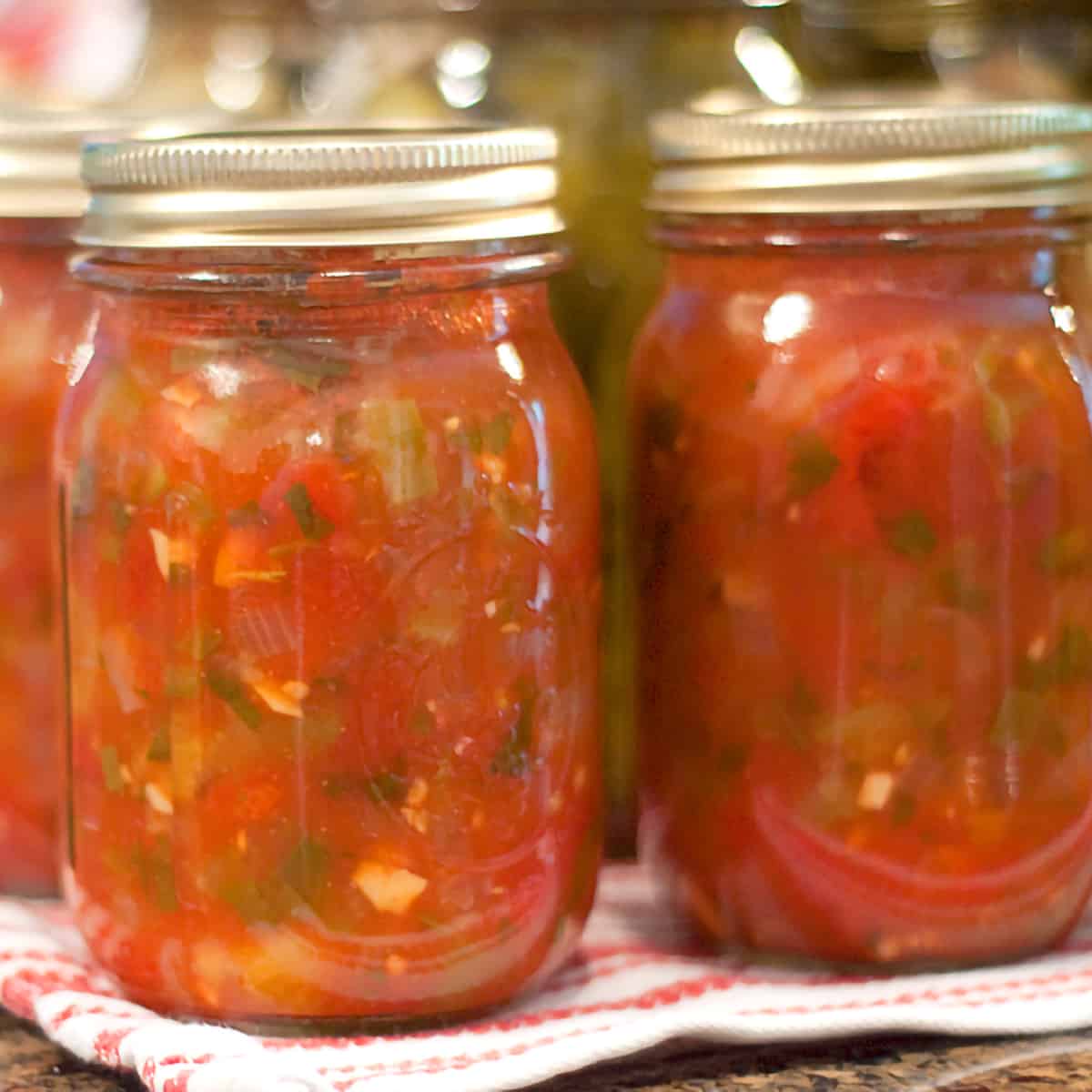
Today I’m sharing my basic canning recipe for salsa. The tomatoes are still coming in and peppers are ready, too, so it was time to go ahead and put up a few jars of this deliciousness to keep on hand for the winter.
It’s so nice to open a jar of homemade salsa when it’s cold out and be able to taste those fresh summer tomatoes once more. Mmmmm. A jar of this in my Salsa Chicken recipe in the middle of winter…well, I have to say it’s just fabulous.
This recipe makes five pints. That’s just about right for our household. If you want to make more, you can double or triple the recipe. Just make sure that you keep the same proportions to guarantee that it’s safe for canning.
Be sure to can enough to use in all your favorite southwest recipes! Of course, it’s great as a dip with tortilla chips, but it’s also fantastic added to tacos and burrito bowls or even in chili.
❤️ Why We Love This Recipe
- Fresh tasting, homemade salsa any time of year.
- Great way to use up garden tomatoes.
- The sense of accomplishment you get from making and canning your own!
🛒 Ingredient Notes
This post contains affiliate links. Lana’s Cooking is reader-supported and earns a tiny commission at no extra cost to you when you shop from our links.
- Tomatoes (I prefer Roma (or paste) tomatoes for salsa, but you can use any variety that you grow or purchase)
- Onions, Green Bell Pepper, Jalapeno Peppers, Garlic (typical salsa ingredients)
- Tomato Sauce (enriches the tomato flavor)
- White Vinegar (I prefer white vinegar because it has a more neutral flavor; it’s possible to use apple cider or other vinegars, but the acidity MUST be at least 5%)
- Sugar (to help mellow and off-set the vinegar flavor)
- Pickling Salt (used for clarity in the finished product – table salts can cause cloudiness)
- Fresh Parsley and Fresh Cilantro (you can use all parsley or all cilantro)
You’ll find detailed measurements for all ingredients in the printable version of the recipe at the bottom of this post.
🥫 How to Can Basic Salsa
- Before you start, get everything you need together. All your jars, lids, kitchen towels, produce, knives, water bath canner, funnel. Everything. It’s so much easier than having to run around looking for something while you’re in the middle of a canning session.
Prepare the Jars and Lids
- Prepare the jars, lids, and rings as usual. You can review how I manage this part of the process in my Favorite Kosher Dills post.
- Fill the canner about 2/3 to 3/4 with water, bring it to the boil, and hold it there until ready to fill the jars. Add the empty, clean jars into the canner and let them sterilize while you prepare the salsa.
There is a good bit of prep work involved in this recipe. It’s not difficult at all, just peeling and chopping. And you begin by preparing the tomatoes.
Prep the Tomatoes
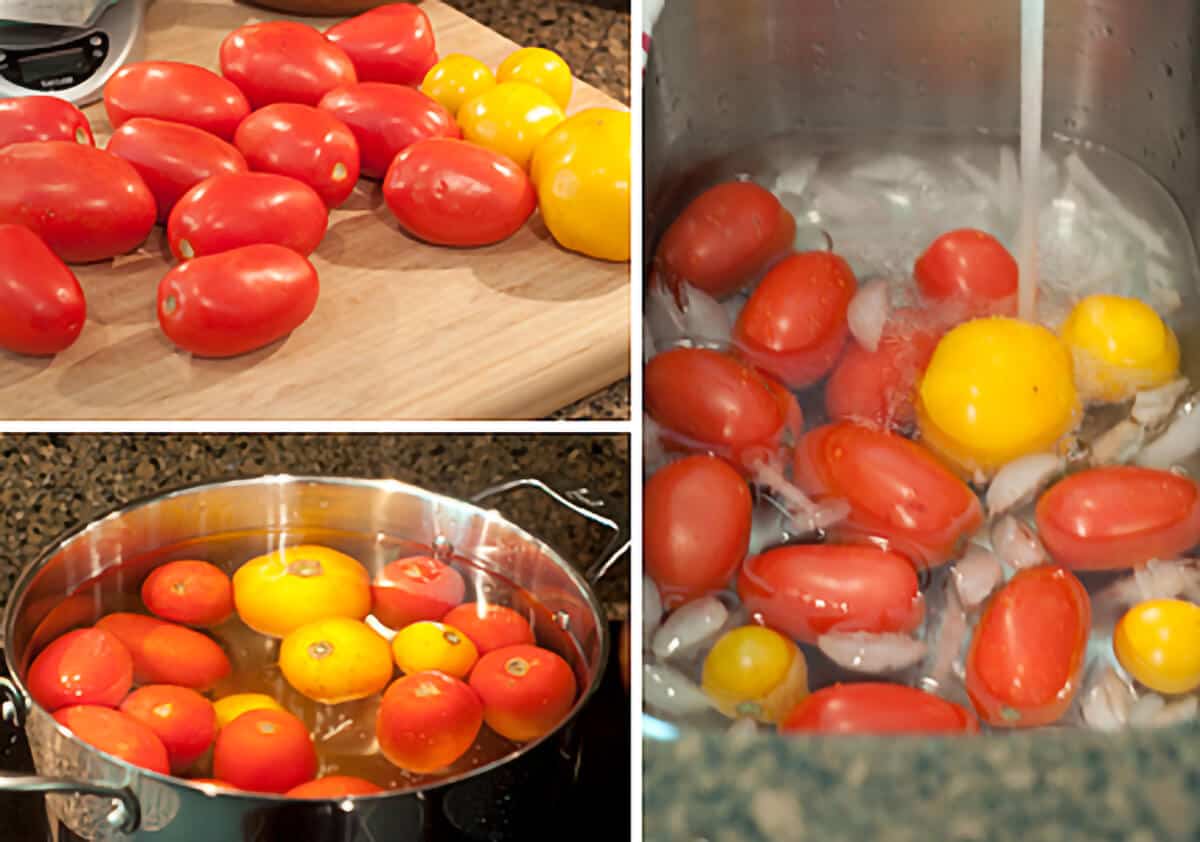
I prefer Roma tomatoes for salsa but I also had a few yellow tomatoes on hand, so I included them as well. You can use any combination and type of tomatoes you like.
To make peeling the tomatoes easy, simply drop them into boiling water for one minute. Then drain them and put them into cold water for a few minutes.
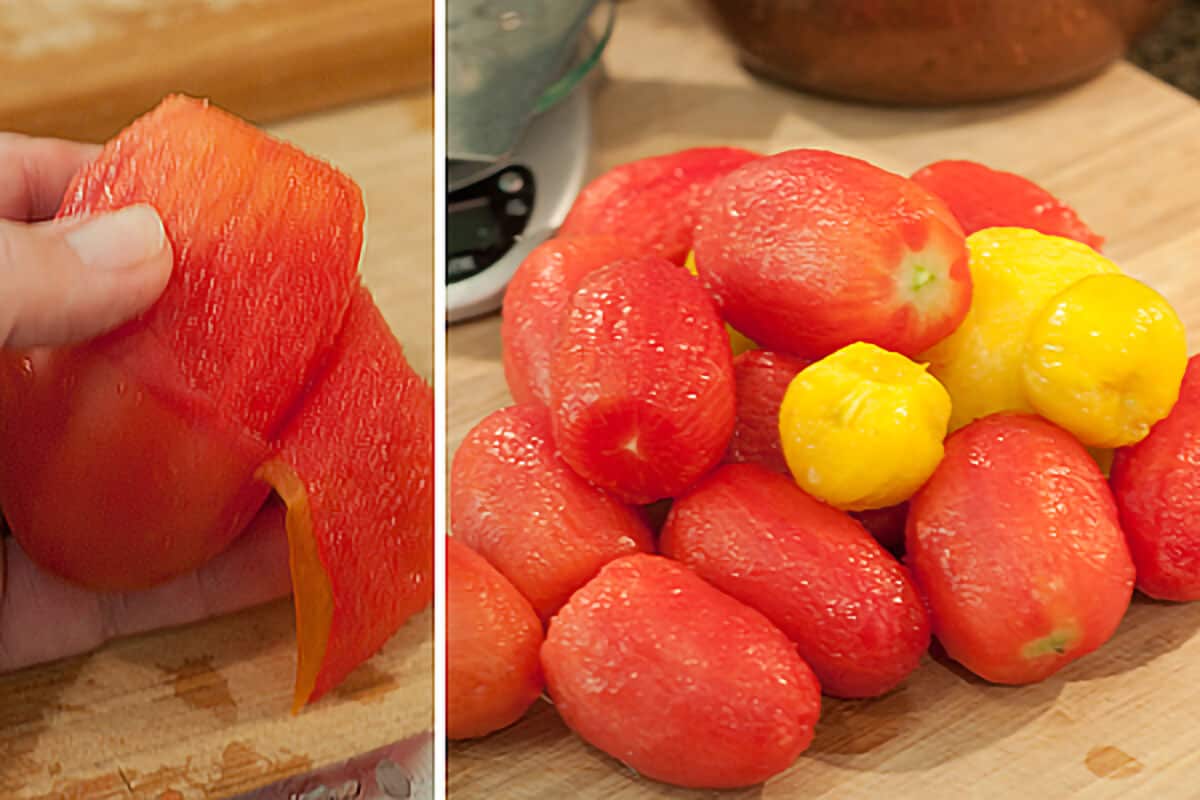
The skins will slip right off. It makes the peeling so simple!
Prep the Remaining Ingredients
I debated about whether to include all the chopping and mincing photos here for illustration purposes. After thinking it over, I decided that if you cook at all, you certainly know how to dice peppers and onions, so I’m sparing you having to scroll past 15 photos of chopped vegetables!
- Chop the tomatoes, onions, green pepper, and jalapenos. Finely mince the garlic. Combine all the ingredients in a stainless steel or enamel saucepan.
👉 PRO TIP: I used three medium-sized jalapenos for this amount of salsa because we like ours fairly mild. You can add up to nine jalapenos if you like it hotter. You could also substitute a hotter pepper such as serrano if you like, but don’t add more than the equivalent of about nine medium size jalapenos so you don’t upset the pH balance of the recipe and make it unsafe for canning!
Cook the Salsa
- Bring the mixture to a boil over high heat. Reduce the heat and boil gently, uncovered, for 25 minutes or until desired consistency, stirring frequently. Your house will smell like the most delicious Mexican eatery by the time this finishes cooking!
Fill and Process the Jars
- Working with one jar at a time, carefully remove a jar from the canner and ladle in the hot salsa to within 1/2 inch of the rim (headspace). Wipe the jar rim with a moist paper towel and apply a lid and ring (just finger tight).
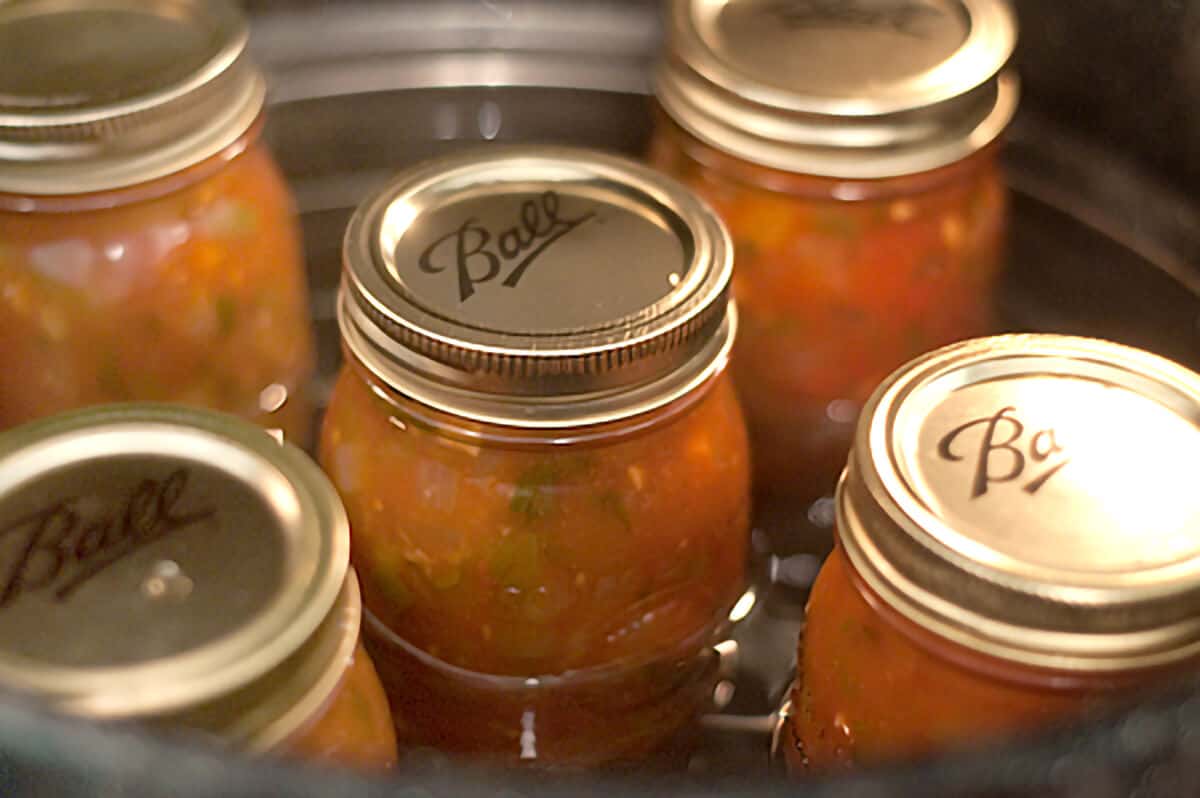
- Return the filled jars to the canner and lower them into the boiling water. Begin timing when the water returns to a boil. Process pints for 10 minutes at 1-1,000 ft. (20 minutes at 1,001 to 6,000 ft. and 25 minutes above 6,000 ft).
Cool Completely
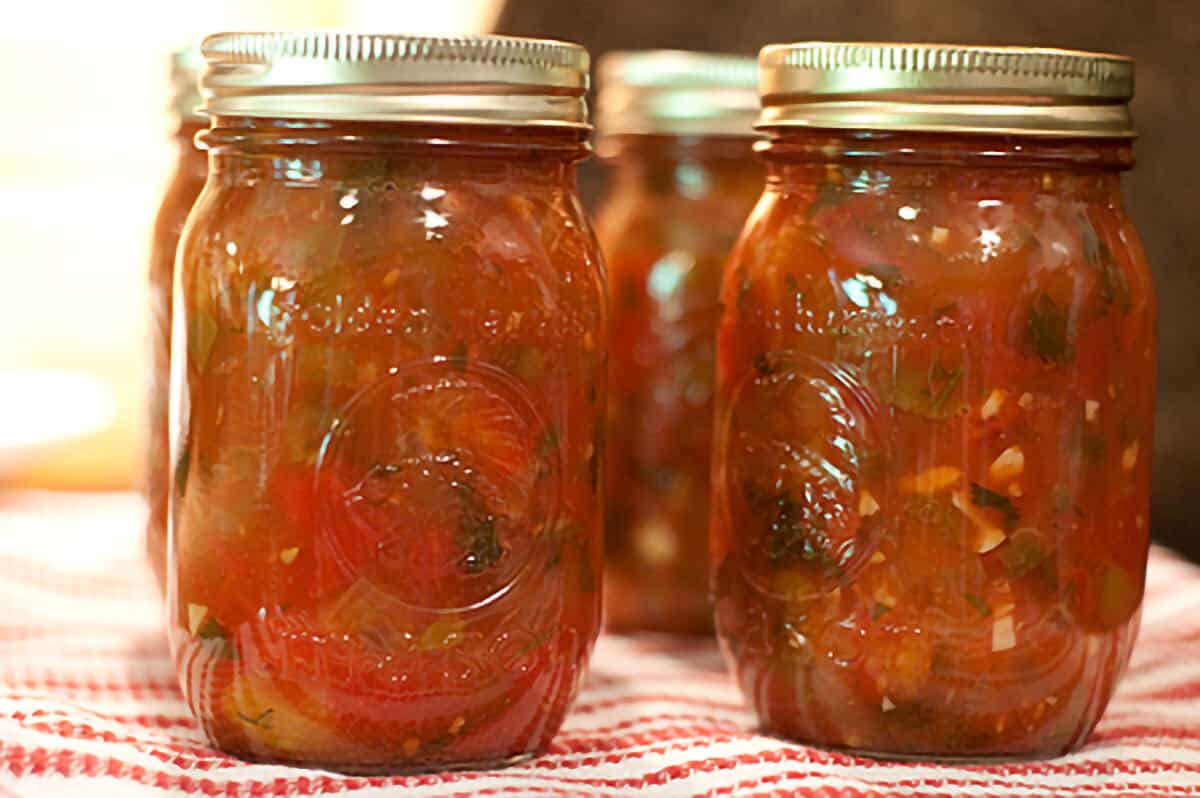
- Remove the hot, processed jars of gorgeous salsa from the canner and set them on a kitchen towel or something similar to give them a little cushion. Let them sit until completely cool – at least 8 hours, preferably overnight. Test to make sure you have complete seals (see How to Test for a Complete Seal), and then store the jars in a cool, dry place until ready to use.
- Allow the salsa to sit for four weeks before using. This will allow the flavors to mellow. Use within one year of canning.
❗ Tips
- After cooking the salsa and before ladling it into the jars, give it a taste. If you think it could use a little more sugar to neutralize the taste of the vinegar, you can add up to one additional tablespoon.
- If you want to add additional vegetables, such as black beans or corn to the salsa, add those after you open the jars for use. Do not add additional ingredients to the recipe. This can alter the pH balance and make the salsa unsafe for canning.
❓ Questions About Home Canned Salsa
Lots of people have asked for a salsa recipe for canning without peeling tomatoes. I will say that you don’t have to peel the tomatoes when making salsa. However, some varieties of tomatoes have skins that become tough and bitter during cooking. Also, many times the peel will separate from the tomatoes while cooking, causing you to end up with a salsa full of floating tomato skins. So, my advice is to always take the time to peel the tomatoes.
Most freshly made tomato salsa recipes contain lime juice. However, lime juice does not have adequate acidity to make salsa safe for canning and storage without refrigeration. That’s why vinegar is used.
You could. Just be aware that once thawed, your tomatoes will not have the same texture. However, you can give it a quick blitz with a stick blender or in the food processor and turn the mixture into a smooth salsa.
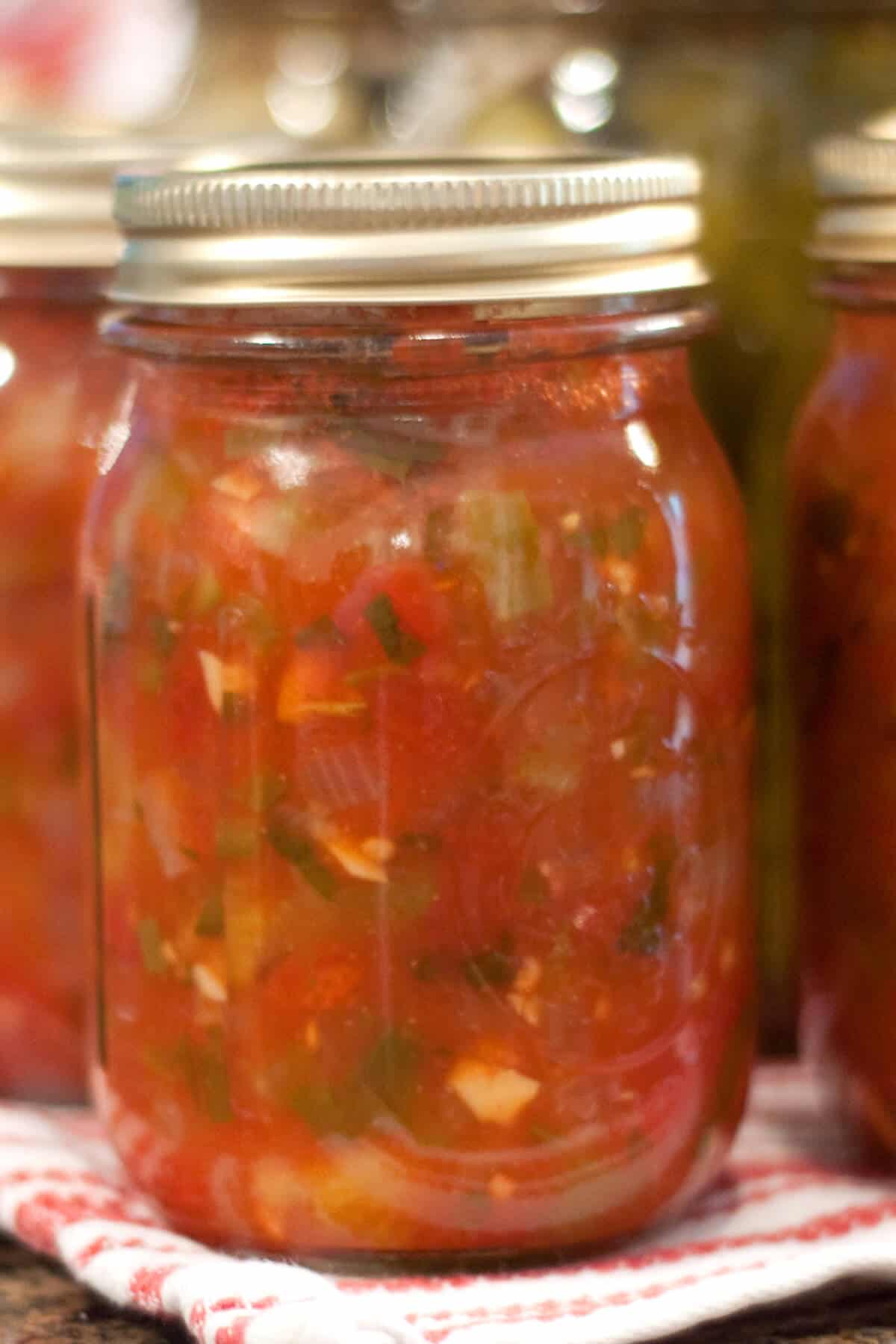

Questions? I’m happy to help!
If you have more questions about the recipe, or if you’ve made it and would like to leave a comment, scroll down to leave your thoughts, questions, and/or rating!
Thanks so much for stopping by!
📖 Recipe
Want to save this recipe?
Enter your email below and get it sent straight to your inbox.
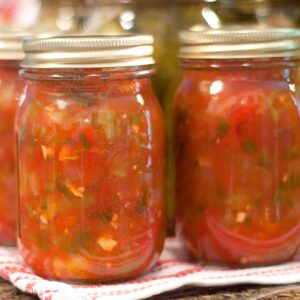
Easy Basic Salsa Canning Recipe
Ingredients
- 3 pounds tomatoes peeled and chopped
- 3 medium onions finely chopped
- 1 ½ green bell peppers chopped
- 3 medium sized jalapeno peppers halved, seeded and chopped (may use up to 9 medium sized jalapenos)
- 9 cloves garlic minced
- 1 ½ cups tomato sauce
- 1 ½ cups white distilled vinegar 5% acidity
- 1 tablespoon granulated sugar (may use up to 2 tablespoons total)
- 1 ½ teaspoons pickling salt
- 1 ½ teaspoons ground cumin
- 1 ounce Italian parsley chopped (about 1/2 bunch)
- 1 ounce cilantro chopped (about 1/2 bunch)
Instructions
Prep Work:
- Before you start, get everything you need together. All your jars, lids, kitchen towels, produce, knives, canner, funnel.
- Prepare the jars, lids, and rings.
- Fill the canner about ⅔ to ¾ with water, bring it to the boil and hold it there until ready to fill the jars. Add your empty clean jars into the canner and let them sterilize while you prepare the salsa.
Cook the Salsa:
- Chop the tomatoes, onions, green pepper, and jalapenos. Finely mince the garlic, parsley, and cilantro. Combine all the ingredients in a stainless steel or enamel saucepan.
- Bring the mixture to a boil over high heat. Reduce the heat and boil gently, uncovered, for 25 minutes or until desired consistency, stirring frequently.
Fill and Process Jars:
- Working with one jar at a time, carefully remove a jar from the canner and ladle in the hot salsa to within ½ inch of the rim (headspace). Wipe the jar rim with a moist paper towel and apply a lid and ring (just finger tight).
- Return the filled jars to the canner and lower them into the boiling water. Begin timing when the water returns to a boil. Process pints for 10 minutes at 1-1,000 ft. (20 minutes at 1,001 to 6,000 ft. and 25 minutes above 6,000 ft).
- Remove the hot, processed jars from the canner and set them on a kitchen towel. Let them sit until completely cool – at least 8 hours, preferably overnight. Test to make sure you have complete seals and then store the jars in a cool, dry place until ready to use.
- Allow the salsa to sit for four weeks before using. This will allow the flavors to mellow. Use within one year of canning.
Notes
- You may use any variety of tomatoes for this recipe. I prefer Roma (or paste) tomatoes.
- I prefer white vinegar because it has a more neutral flavor; it’s possible to use apple cider or other vinegars but the acidity MUST be at least 5%.
- The sugar in the recipe helps to mellow and off-set the vinegar flavor – taste after cooking the salsa and add more if needed (up to 1 additional tablespoon).
- If you want to add additional vegetables such as black beans or corn to the salsa, add those after you open the jars for use. Do not add additional items to the recipe. This can throw off the pH balance and make your salsa unsafe for canning.
Nutrition Information
Nutrition information is calculated by software based on the ingredients in each recipe. It is an estimate only and is provided for informational purposes. You should consult your healthcare provider or a registered dietitian if precise nutrition calculations are needed for health reasons.
— This post was originally published on September 10, 2010. It has been updated with additional information.

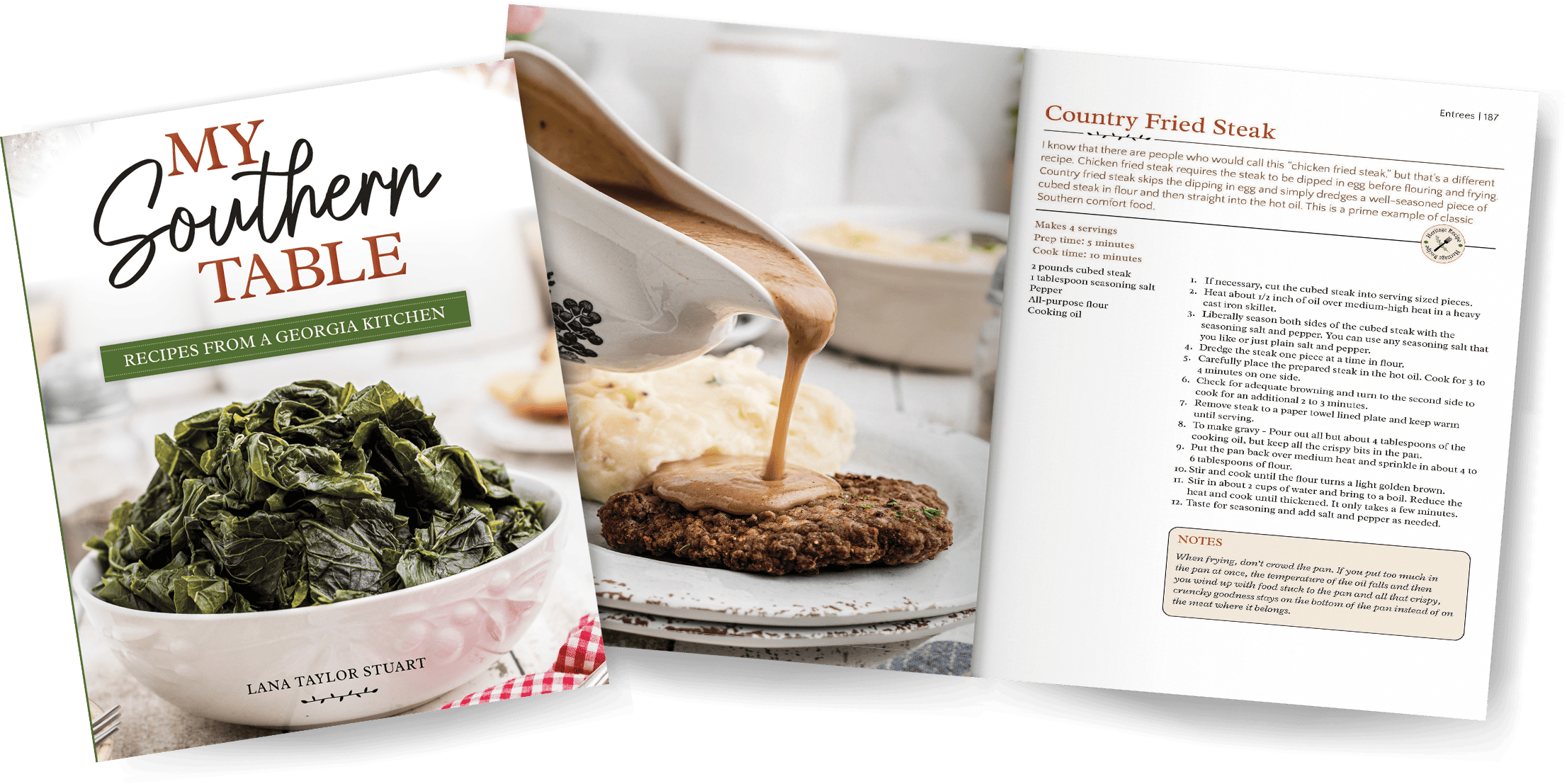
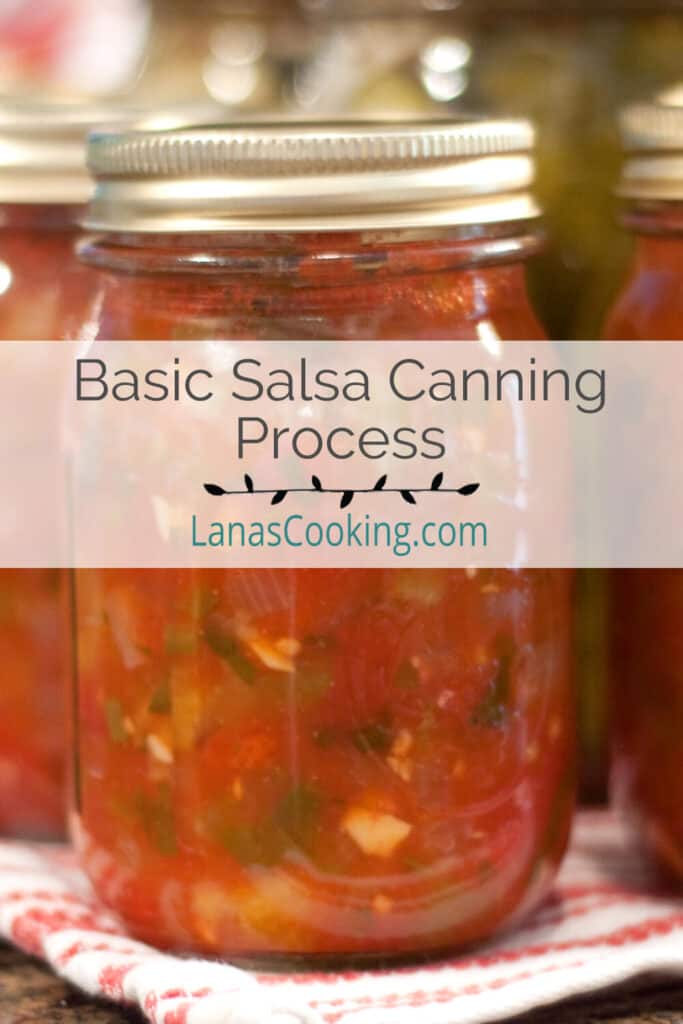
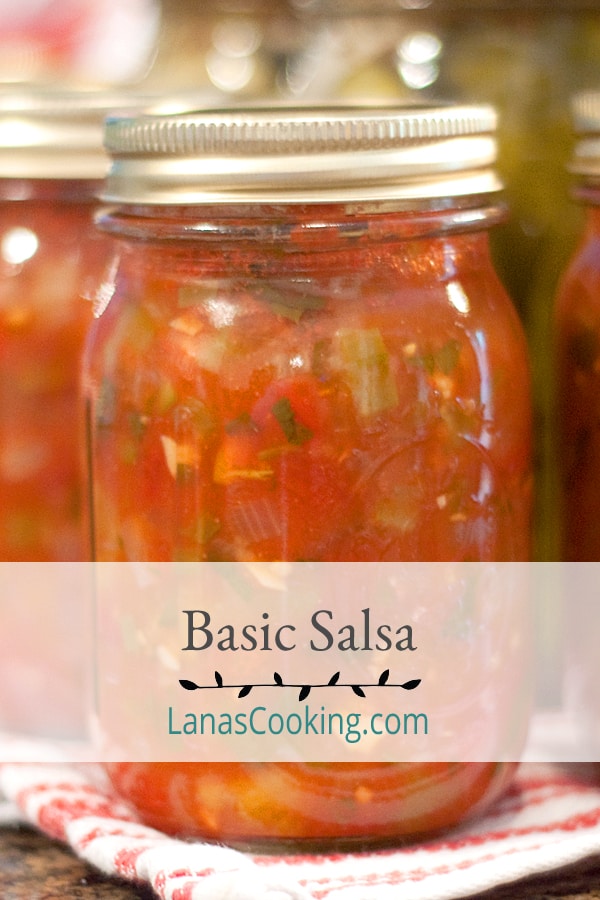
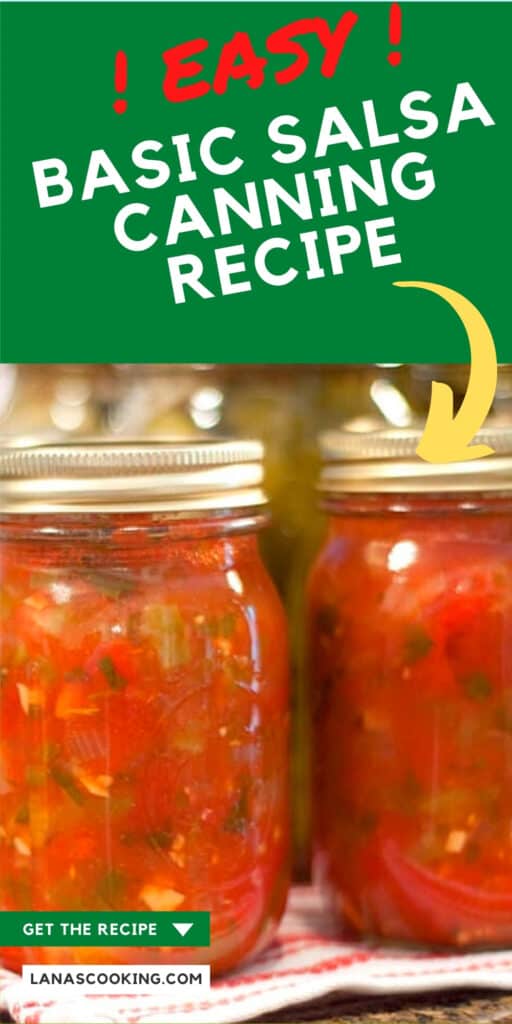
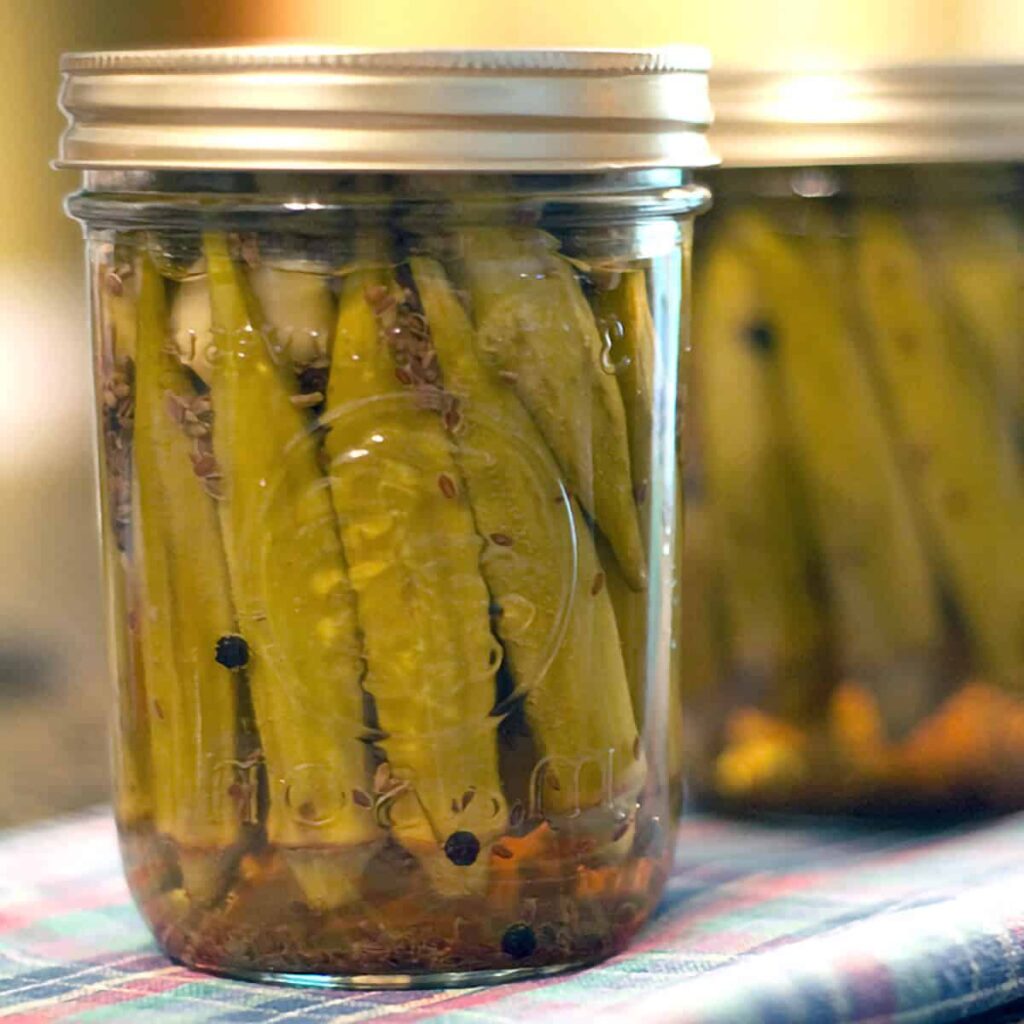
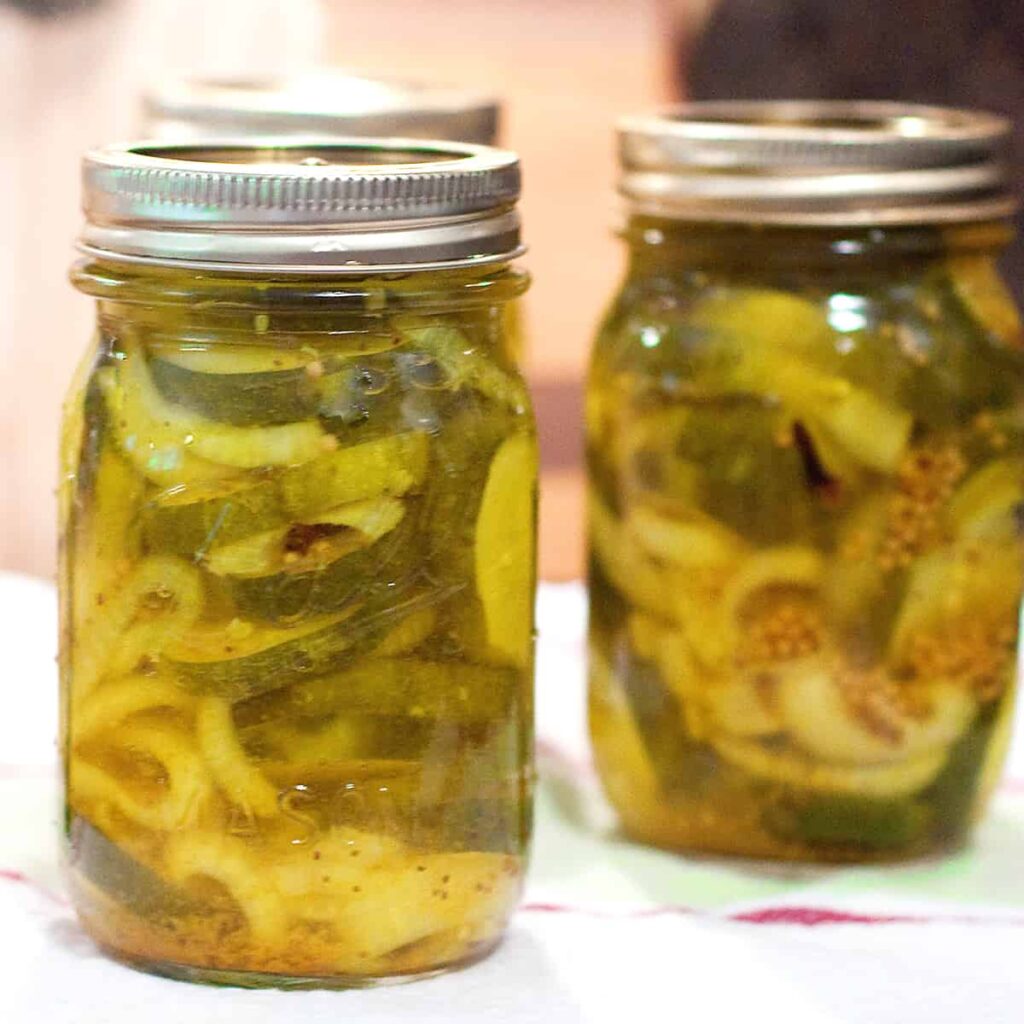
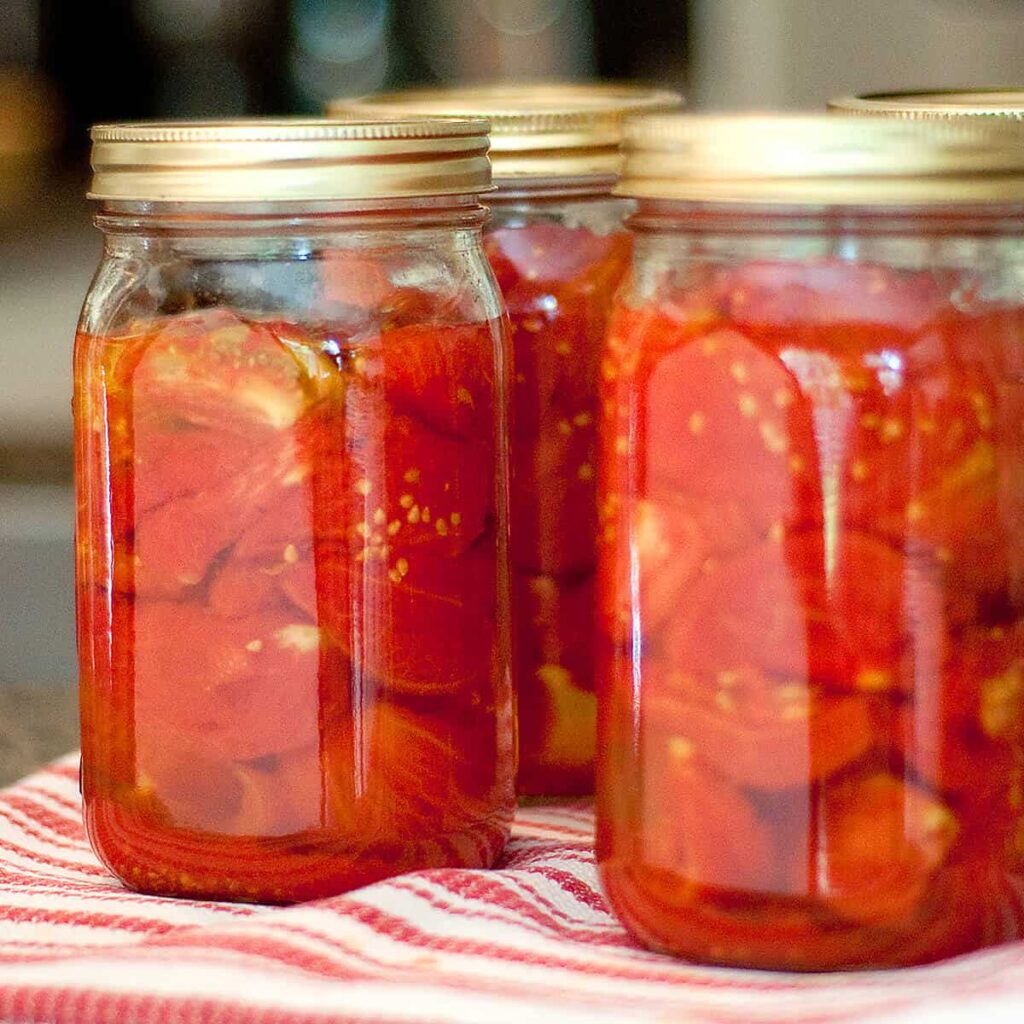
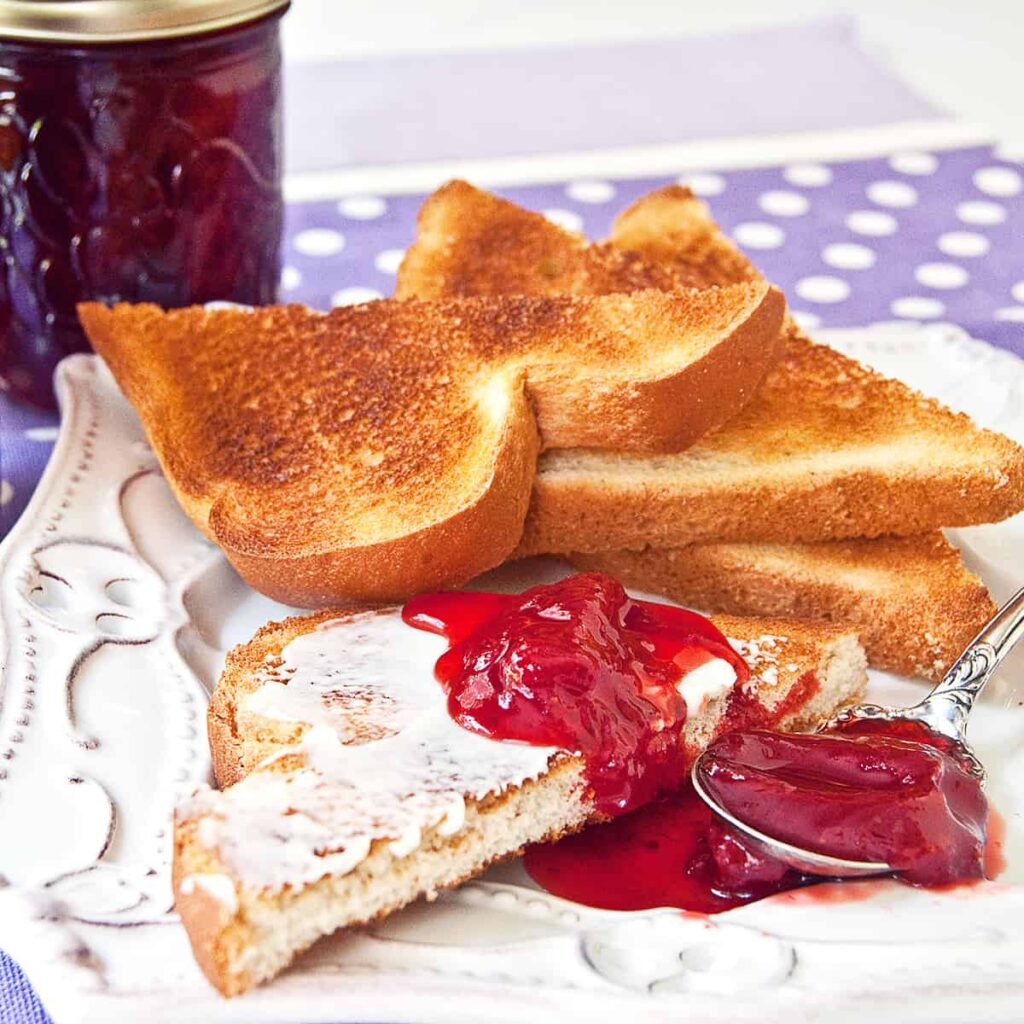
Can I use canned tomatoes to make this?
I haven’t tested this recipe using canned tomatoes.
There are no instructions on when to add the spices and herbs. Can fresh cilantro/parsley be eliminated?
In Step 4, “Combine all the ingredients in a…..” means all of the ingredients, including spices and herbs. Yes, you can omit the cilantro and parsley.
I followed your recipe as is and there seems to be a strong vinegar taste. I added the additional 1 tblspn of sugar as stated in the recipe and it helped but did not take all the vinegar taste away. Will that dissipate as it is stored for the four recommended weeks?
Some brands and types of vinegar have a stronger taste than others. If the vinegar taste is still too strong for you when you open the jars to use the salsa, you can add more sugar at that time to neutralize it. Be sure to keep the salsa refrigerated once it has been opened.
is 10 minutes enough time for processing on your recipe seems like other recipes call for more time at an elevation below 1000 thank you
I believe the recipe is safe with 10 minutes processing time, but you can increase it if you like. It won’t hurt anything to process longer.
Hi! Stumbled upon your recipe and it looks fab! Can’t wait to try it. My question is, do I have to add tomato sauce to it or can I add extra chopped tomatoes to keep it a little on the chunkier side? Thanks :-)
Because this is a canning recipe and has been tested using these exact measurements and ingredients, I can’t recommend making any changes that might affect the pH which could cause the product to be unsafe for storage. If you want to change ingredients (either amounts or products), you’d have to store it in the refrigerator and use it within a few weeks.
Is it okay to blend all the ingredients in a blender before cooking?
Because this is a canning recipe, I would advise to make it exactly as written. If you want a smoother salsa, you could blend it as you open each jar to use it.
Do you have to use tomatoe sauce the idea of using fresh ingredients is to not use canned
This recipe is safe for canning as written. Any changes in ingredients may render it unsafe for pantry storage. This blog does not accept responsibility for food poisoning caused by changes made to canning recipes.
If you want to change the ingredients and make this into a fresh salsa, feel free. However, there’s no assurance that it would be safe for canning or for storing outside of refrigeration.
do you seed the tomatoes?
It’s up to you. I recommend plum (Roma) tomatoes which have fewer seeds and are generally more “meaty” than other tomatoes so I don’t seed them. If you use a variety that has lots of seeds, you might prefer to remove that part.
I am so glad I read the comments on this recipe, though not all 96 comments appeared. They answered some questions I had about what to substitute if I don’t have the green peppers. I will use 9 Jalapenos, and an extra onion instead This recipe is a life saver while I gaze upon the 2/3 bushel box of Jalapeños, 1/3 box of Serano peppers and 25lbs of red onions on the floor of my kitchen. The only thing uncertain is whether I can double the recipe without jepordizing it’s acidity integrity! I have already 3/4 of a gallon of fresh tomatoes peeled, in 1/8th pieces that I have stewed up to almost sauce consistency! Great gobs of goulash this is going to be one fun canning job! Your recipe is helping me meet my canning goal pretty much! i love that you provided nutritional data which i am tracking to meet my home ‘s annual nutritional needs! Thank you for your answers to other’ questions!
Hi Lana,
As per the USDA, bottled Lime juice (and/or Lemon juice) can be substituted for 5% vinegar 1 to 1. But if a recipe calls for bottled lime/lemon juice, you cannot substitute vinegar in its’ place. That’s because the lemon/lime is actually more acidic than 5% vinegar. From their page;
“The purpose of the commercially bottled lemon or lime juice is to standardize a minimum level of acidity in the recipe. For the purposes of our testing, we used lemon juice as it was deemed the most acceptable flavor for the proportions in this particular recipe. For safety reasons, do not substitute vinegar for the lemon or lime juice.”
Personally, I prefer citric acid. Less liquid and a small amount is equivalent to a lot of lemon or lime juice. Your recipe is very similar to choice salsa on the USDA National Center for Home Food Preservation website (where the quote above comes from). They specify lemon or lime juice though, not vinegar. Just pointing this out because the lemon and/or lime juice can be used and has a better flavor in my opinion.
Can I reduce the amount of jalapeño to one without effecting the integrity of the salsa
Yes that should be fine.
I have a lot of green zebra tomatoes this year. Is it alright to use them maybe mixed with some other types of tomatoes for the salsa? Thanks!
They should work but if they’re very juicy, you may wind up with a thinner salsa.
I am just about to jar the salsa, and couldn’t resist a ‘taste’ test. The overall flavour is perfect, right amount of heat, but… I found the vinegar over powering!!! There were a couple of things that I adjusted in the recipe, simply because I did not have them in my larder:
#1, I used a 7% white vinegar (recipe does say to use at least 5%), and
#2, I did not have any green peppers, so omitted them.
I am at home nursing COVID (tested Positive on Friday morning, it is now Monday) – I live alone, and simply did not want to bother anyone to pick up and deliver green peppers.
I will continue with the canning process, and hope that the 4-week (I believe the recipe recommended 4 weeks) mellowing time will reduce the vinegar content!! Unless anyone has any other suggestions. I have already added an additional 1Tbsp of Sugar (3 in total) but am reluctant to add anymore as I don’t want to upset the flavour.
If I were to try the recipe again, I would cut the vinegar to 1/2 cup, and perhaps add 1/2 cup lime juice🤷🏻♀️
I should mention that I am new to canning, and will be (and will not be) disappointed if I have to trash this batch – I went into it with the attitude of ‘Try it and See!!’ Just disappointed that I have used up my fresh tomatoes, (and all of the time spent chopping and mincing, as I do it all manually).
Gail
Canning is a very exact science and canning recipes should be followed exactly in order to keep the correct pH balance of the ingredients. Canned foods require a specific pH level in order to be shelf-stable and free from botulism. The 5% vinegar in this recipe ensures that stability. The vinegar can’t be substituted with lime juice because it’s not acidic enough. Also, if you omitted the peppers and didn’t increase another vegetable to compensate for them, that could have thrown off the balance of the recipe. You also indicated that you’d added more sugar than the tested recipe allows for which would also throw off the pH. My advice would be to store your salsa in the refrigerator after the jars cool completely. With all the changes you made to the recipe I can’t assure you that your finished product will be safe to consume if stored at room temperature.
Well. my friends who have tried this salsa said it was my best yet! So Thank you for sharing your recipe! I had very few roma type tomatoes & found that it was basically green pepper, jalapenos and onion in a tomato broth. So I got my hands on some small romas and quickly washed and chopped (no peeling) them. Once I added them, I let salsa boil a bit longer and tried the salsa again just prior to canning. It was excellent! So next time I will make sure to limit the variety of tomatoes that have a lot of seeds or I will remove the jelly and seeds and only use the meaty parts. The majority of the tomatoes I originally started with were indeed small & therefore they had quite a bit of jelly and seeds inside which is why the salsa was more like a tomato based veg soup. This of coarse had nothing to do with the recipe, it was excellent. Thanks again!
I’m so glad you and your friends are enjoying the salsa, Jennifer. And, you’re right, the type of tomato makes a huge difference.
I love this recipe for salsa and so does my family,l leave seeds in hot peppers for the perfect heat.
Thanks Anthony
I’m so glad to know that your family enjoys the recipe! And, yes, it’s easy to adjust to the heat level that you like.
Family loves it!
Great!
Hi. I can a lot! And I know the amount has to be exact when water bathing food. I have 2 bushels of tomatoes. How many cups is 3 pounds. I don’t have a kitchen scale. I’ve not really needed one as usually measurements have been in cups or 1 onion or pepper etc. although it could be a large pepper or a small one which could again throw off the acidity in a recipe as cup measurements are not used. Thanks for your help
Hi Terri – First, I would encourage you to invest in an inexpensive kitchen scale. I use mine constantly and they’re well worth the few dollars they cost. As far as the tomatoes, one pound of tomatoes generally yields 1 1/2 cups when peeled and chopped. One medium onion yields about 1 cup chopped and one bell pepper the same.
Thanks so much. I’ll make the salsa today and look for a scale soon !
Thanks so much. I’ll make the salsa today and look for a scale soon !
Tried this recipe my family and friends loved it.
So glad you like it! It’s really nice to have on hand through the winter when fresh tomatoes just aren’t available.
The recipe states to cook the salsa in a stainless steel or ceramic pot. I do not have these; is it ok to use an anodized nonstick pot?
It actually says to use stainless steel or enamel, not ceramic. That’s because those surfaces are non-reactive with acidic foods. According to a quick Google search “non-reactive types of products include stainless steel, hard anodized, glass, ceramic, enamelware, clay/earthenware, and most nonstick surfaces.”
Thanks
Keep the recipes coming!
Can I use store bought cans of stewed tomatoes to make the salsa ?
I don’t have any information on how to substitute canned stewed tomatoes in this recipe. No idea what the pH of them might be or how they would affect the outcome.
Lana I am in a low salt diet. I wanted to make my own salsa with no salt. Is that possible
Yes, you can. Salt isn’t necessary for preservation in this recipe. It’s for flavor only.
I’m getting ready to make this salsa… do I need to drain the tomatoes after I peel and chop them or just leave the liquid?
No need to drain them, just leave the liquid.
This is going to be my salsa recipe! It’s gòt the perfect mix of heat, tang, and sweetness, and the tomato sauce gives it richness and body. I can’t wait to see how it is in four weeks.
So glad you like it, Heather! I usually make it once a year to have on hand for winter. You’ll love having those fresh flavors on cold days.
Lana,
Do you blanche the tomatoes before peeling and chopping them up?
Excited to make your recipe :)!
Tresa
It’s optional. I do blanch them to make them easier to peel. It’s the first step I show in the body of the post. If you don’t want to blanch, that’s fine, but they should be peeled.
I planted the small tomatoes. Can I leave the Skin on and use the food processor to chop everything?
Do you mean cherry tomatoes? I haven’t used a processor for this recipe, but you could give it a try. Just be sure not to chop too finely or you’ll wind up with tomato sauce. A word of warning about about cherry tomatoes — they have lots of seeds.
I have a salsa recipe that I make in small amounts that is usually consumed in a few days, but I would like to try canning it. However, due to my lack of experience in canning, I’m not sure how to accomplish it. My recipe has no pickling salt or vinegar, but it does have regular table salt and lime juice. If I can this recipe, how can I ensure that the proper Ph is maintained?
Canning is very exact science. It requires a specific pH level in the food in order for it to be shelf-stable and free from botulism. To be honest, you’d need to have a food lab test the recipe to determine whether it is appropriate for canning. All the canning recipes I post are from USDA approved sources.
I tried this recipe today for the first time. I had a small amount left over that wouldn’t fill a full jar so I tried it with some tortilla chips. It was delicious. It has a very nice flavor but the vinegar is very prominent. Does this mellow after being in cans for awhile?
Sheryl
The taste doesn’t change significantly during storage. Interesting, though, I’ve never noticed a predominant vinegar taste with this salsa.
Hi! I have a question about the water bath photo. I always make sure the water is over the jars by at least 2 inches. Your photo looks like the top half of the jars are above the water and not completely submerged. Can you explain this to me? If that’s the method I should use for canning anything with tomatoes it would explain why I sometimes get water inside my sauce jars. Thanks!
Hi Bernie – yes, I can see how that photo would be confusing. The jars are sitting in the rack which is hooked over the sides of the canner. They haven’t been lowered into the water yet. The standard is that the tops of the jars should covered by at least 1″ of water and they would be when lowered into the canner.
For the amount of tomatoes…
Is this 3 lbs before they are peeled and chopped, or is 3 lbs the quantity needed after they are peeled and chopped? Past experience peeling tomatoes for canning tells me you can lose a lot of “product” during that process.
It’s 3 pounds before peeling. I lose very, very little in the peeling and chopping.
First time making this recipe. Great recipe and the finished product is worth the process.
So glad you enjoyed making it, Sonya! I love having this fresh salsa for the winter.
Hi there! Just finished canning this recipe and it looks delish! Just wondering what the shelf life is and the best way to store the jars? :-)
Lehran, you should store the jars in a cool, dry place and use the salsa within one year.
I just made this today, my goodness it smelled delicious!!!! I just started canning a few months ago and this is my first attempt at salsa. Can’t wait to try it. Thanks
Hope you enjoy the salsa, Deborah. It’s a long-time favorite recipe of ours.
I am wondering if it’s possible to use cider vinegar, as that is what I have used in the past. I don’t know the recipe anymore but I do remember that I used cider vinegar. Thanks in advance for your help!
If your vinegar is at least 5% acidic then it’s safe to use for canning. It will, however, change the taste of the salsa quite a lot.
Quick question. You use the water bath method for canning. Can you just put steaming hot salsa in a jar and seal the jar that way, without boiling the jars at the end? Thanks!
Jason – You can do that, but after the jars and contents cool down (about 24 hours) you’ll have to store them in the refrigerator and use them within a month or so. To keep them in the pantry not under refrigeration they must be sealed using a water bath. Water bath sealed jars are safe to store out of the refrigerator for up to a year.
This salsa sounds so good. Could I add some black beans and yellow corn to it without changing the ph for canning?
Sharon – Sorry but either black beans or yellow corn would make this recipe unsafe for water bath canning. You could, however, make the salsa according to the recipe and add those when you open a jar for use.
I love salsa and I love your pics. great post!
Can I use this canning process for Cherry Salsa also?
Mary, It would depend on whether the recipe for your Cherry Salsa is safe for canning. You should always use a USDA tested and approved recipe which will include the correct headspace, jar size and processing time.
This looks great! I have 7lbs of tomatoes that need to be used this week, so I’m going to try this tomorrow night.
Do you remove the seeds from the tomatoes? Does it matter whether they’re there or not? I’ve never made salsa before at all, but I’m sure I can do better than the store-bought stuff! Thanks!
Catherine – I don’t remove the seeds. Just peel and chop.
This looks amazing. I want salsa, on everything. I make it but in 2 jar amounts and never to can. I have been thinking of doing canning and I just got my hands on a Blue Book. Can’t wait to begin. I need more jars, and 2 other things that I saw at Ace last week. I am going back this weekend to get them.
This is a really nice, all-purpose mild salsa that is easy to make and can. I try to make a batch every summer when tomatoes are plentiful and it lasts us all year. Hope you enjoy it!
I just made this recipe!
No chopping problems with the Kitchen Aid food processor and a helpful husband.
Fabulous Recipe!!
I doubled the recipe…my only suggestion is adding a 6 oz. tin of tomato paste at the end of the cooking time to the salsa. This made the finished product thick & rich, like store bought.
I made homemade foccacia bread and we couldn’t wait for the salsa to cool down to sample it….we devoured this wonderful full flavoured salsa with the bread. YUM!
Thanks Lana,
Edie
Hi Edie – so glad you enjoyed the recipe. Your suggestion for adding tomato paste probably does make a richer product, but it alters the pH balance of the recipe making it questionable for home canning. With the additional tomato paste, I’d store it in the refrigerator.
Beautiful Sauce! So mouthwatering!
hello,
Its easier to peel tomatoes by cutting an x at the top before boiling and then cooling and then peeling. also a note of caution many home canning mishaps end up sending many a friend to the hospital for food borne illness with special emphasize on the deadly disease botulism. Botulism which is an endospore bacteria can become active and grow under favorable conditions, these conditions can consist of an improper canning environment too much oxygen available or improper heating and sealing techniques. Endospore forming bacteria can live within our soil as well as plants and animals. These bacteria can remain in a dormant state for thousands of years before being activated by proper growth conditions, such as your home canned salsa. Don’t mean to come down on the recipe, just the food microbiologist within me comes out when recipes of these sort cross my path.
Hello Kayla,
Thanks for your comment. My method of peeling tomatoes works great for me.
The salsa recipe is a USDA tested and approved canning recipe. The amount of vinegar in the recipe makes the pH of the finished product shelf stable and safe for canning as long as proper procedures are followed. I have been canning for more than 35 years and am careful to always use tested recipes. I encourage all new canners to become familiar with proper home canning techniques. I would not post a recipe on my blog if there were any question as to its safety for home canning.
You are on the canning kick too!!! Nice! I need to take advantage of our garden Roma tomatoes as well and put up a batch of salsa. Your salsa looks wonderful.
Bon appetit!
CCR
=:~)
I am, Ryan! And I have some more things to post soon. Stay tuned!
Looks like you got one too many jars of salsa there. Mind sending one my way? jk hehehe…
Ha ha, Jenn. Nope, sorry, that’s just the right number of jars for us!
I never thought to try to can salsa. Smart idea!
Looks fantastic! Great photos. Do you know if salsa does alright in the freezer too? Then I could be lazy and skip the whole canning thing…lol
Alta – I really don’t know how freezing affects salsa. I’m thinking maybe you’d end up with a watery product after it thawed. Just not sure.
I am so impressed…your canned salsa looks fantastic!
I’m going to be especially jealous this winter when you are popping open jars of fresh salsa. This looks delicious!
Hi, Lana,
Thank you so much for such a detailed comment. With my luck, I found your canning instructions after I processed 15 jars of jam. I was scared about the process. They have been refrigerated. I hope to follow your instructions for Salsa and cucumbers soon. You do not have instructions for just tomatoes. I will have to look on your blog before the tomatoes overwhelm me. I so appreciate the comment. Have a great day. -Tien
Salsa can be quite expensive…it’s so much cheaper, fresher, and nutritious to can your own! The colors are gorgeous, too!
OMG! This looks fabulous!! I’m heading over to the farmer’s market today to pick up the ingredients !! So happy to have found your blog, it has inspired me to get back to canning again!!!
Hi Anna. I’m glad I could be an inspiration for you to get in the kitchen and can something! It’s one of the things I enjoy doing the most. Having delicious canned goods during the cold winter months is worth all the effort!
I LOVE it! Thanks for this post. I am always in the market for a good salsa recipe and since my first canning adventure earlier in the year, I’m ready to do it again! Great pics, too!!
I really admire people who are into canning. I just don’t have the inclination or patience but I wish I did, especially when winter rolls around and I’m missing all those veggies.
This makes me want to try canning for the first time.
Jump in and give it a try, Steve. I always advise people who’ve never canned to purchase the Ball Blue Book and follow its instructions. Start with something simple, like strawberry jam, and you’ll soon understand the process. I’m always happy to answer questions, too.
It’s about to be apple season, and applesauce is crazy easy to can, too.
Yes, it is easy, although I usually freeze my applesauce.
Oh, I am so sorry I commented! I just realized that this is a super old post. Again, so sorry about that. I don’t know how I came across it.
No problem, Betsy! I love comments whether they’re on old or new posts. You may have gotten to this one from Facebook since I posted a link to it on there just yesterday. I thought it was a good time to bring it up again with tomatoes in season right now.
I just had quesadillas this morning and was missing salsa. Now, I wish I could have made this!! I’m bookmarking this recipe. Thanks!
This looks fabulous!! I have an obsession with Newman’s Own salsa, but really think I need to try making my own now :)
Canning seems like such a huge undertaking to me since I’ve never done it before, but it must be nice to be able to enjoy your salsa when winter rolls around. :-)
Jean, it does require some special equipment – a canning pot, jars, lids, rings – but the rewards are well worth the investment.
I have so many peppers this year – I can’t wait to do this. Thanks for posting this great looking sauce!
Perfect timing Nana! I am in a canning kick too, just put up some Pickled Grape Tomatoes this past weekend and my canning “ToDo” list has some “New Dill” cucumbers, salsa, fire roasted tomato sauce, and a few others to “put up” my garden harvest.
Your salsa is a perfect recipe, I too prefer the Roma’s for my salsas.
Bon appetit!
=:~)
This looks totally gorgeous! Thank you for the recipe lana, I have bookmarked it :)